

Plants. Green Bean Germination. Plant parts. Parts of plants (roots, stem, leaf, flower, fruit, seed)_questions and answers. The Parts of a Plant-(good for revision) What Is A Seed? Life cycle of a plant. What is Germination?Life cycle of a plant Mocomi Kids. How Do Seeds Sprout? Have you ever planted a seed and watched it grow?
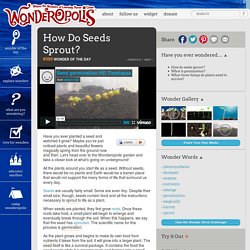
Maybe you’ve just noticed plants and beautiful flowers magically spring from the ground now and then. Let’s head over to the Wonderopolis garden and take a closer look at what’s going on underground! All the plants around you start life as a seed. Without seeds, there would be no plants and Earth would be a barren place that would not support the many forms of life that surround us every day. Seeds are usually fairly small. When seeds are planted, they first grow roots. As the plant grows and begins to make its own food from nutrients it takes from the soil, it will grow into a larger plant. The three things plants need to grow are light, food and water. Like all living things, plants need water. When you get dry seeds at a gardening store, the seeds are dormant, which means they’re inactive. Amazingly, scientists still don’t fully understand what all happens inside of a seed as it comes to life.
Sid The Seed. How Does A Seed Become A Plant? How Does a Seed Grow? My seed diary. Fun Science Experiments for kids. The Color-Changing Celery Experiment! Good for summarising. Parts of a Plant for kids - Functions of different parts -Animation-Quiz. The Science of Spring: plant, grown, learn. Apple Seeds come in all shapes, sizes, and types.
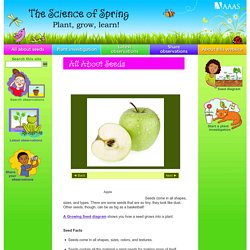
There are some seeds that are so tiny, they look like dust. Other seeds, though, can be as big as a basketball! A Growing Seed diagram shows you how a seed grows into a plant. Seed Facts Seeds come in all shapes, sizes, colors, and textures.Seeds contain all the material a plant needs for making more of itself. Suggested Reading A Seed Is Sleepy, by Dianna Hutts AstonHow a Seed Grows, by Helene JordonFlip, Float, Fly: Seeds on the Move, by JoAnn Early MackenA Fruit Is a Suitcase for Seeds, by Jean RichardsFrom Seed to Maple Tree: Following the Life Cycle, by Laura Purdie Salas. Do All Plants Have Roots? Have you ever stopped to take a look at the world around you and think about how many different types of plants you see?
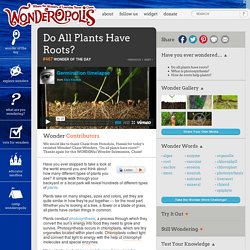
A simple walk through your backyard or a local park will reveal hundreds of different types of plants. Plants take on many shapes, sizes and colors, yet they are quite similar in how they’re put together — for the most part. Whether you’re looking at a tree, a flower or a blade of grass, all plants have certain things in common. Plants conduct photosynthesis, a process through which they convert the sun’s energy into food they need to grow and survive. Photosynthesis occurs in chloroplasts, which are tiny organelles located within plant cells. Many plants, such as trees and flowers, have vascular systems. The roots, for example, have several important functions. Carrot Experiments.
Make a Carrot Pump What You Need: A clear glass or plastic cup; A small carrot that will fit inside the cup; A clear plastic straw; Four toothpicks; A candle; A few drops of ink or food colouring (optional) What To Do: 1.
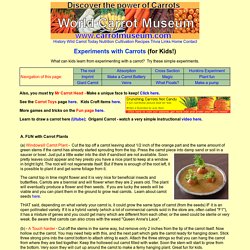
Scoop the leafy top out of the end of the carrot, making a small hollow. 2. Gardenglove. Parts of a plant. Biology of Plants: Plant Parts. What Do Different Plant Parts Do?
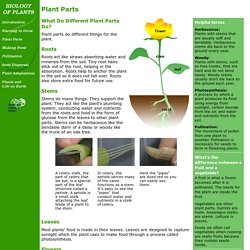
Plant parts do different things for the plant. Roots Roots act like straws absorbing water and minerals from the soil. Tiny root hairs stick out of the root, helping in the absorption. Roots help to anchor the plant in the soil so it does not fall over. Stems Stems do many things. Leaves Most plants' food is made in their leaves. Label the Parts of a Plant Worksheet. Parts of the plants-activity_1. Parts of a plant_Flash interactive activity. Science Game and Lesson Plan for Kindergarteners. Plants powerpoint: parts and needs (easy)